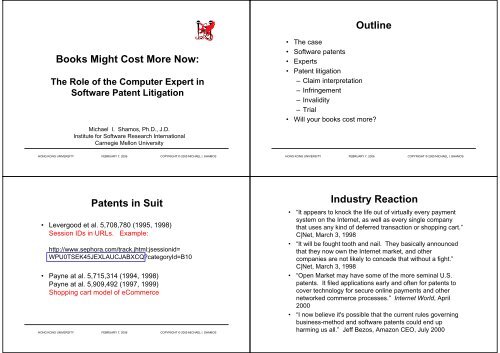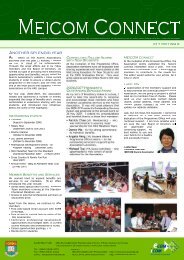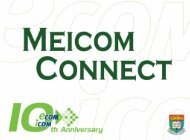pdf file - Master of Science in Electronic Commerce & Internet ...
pdf file - Master of Science in Electronic Commerce & Internet ...
pdf file - Master of Science in Electronic Commerce & Internet ...
Create successful ePaper yourself
Turn your PDF publications into a flip-book with our unique Google optimized e-Paper software.
Outl<strong>in</strong>e<br />
Books Might Cost More Now:<br />
The Role <strong>of</strong> the Computer Expert <strong>in</strong><br />
S<strong>of</strong>tware Patent Litigation<br />
Michael I. Shamos, Ph.D., J.D.<br />
Institute for S<strong>of</strong>tware Research International<br />
Carnegie Mellon University<br />
• The case<br />
• S<strong>of</strong>tware patents<br />
• Experts<br />
• Patent litigation<br />
– Claim <strong>in</strong>terpretation<br />
– Infr<strong>in</strong>gement<br />
–Invalidity<br />
–Trial<br />
• Will your books cost more?<br />
HONG KONG UNIVERSITY FEBRUARY 7, 2006 COPYRIGHT © 2005 MICHAEL I. SHAMOS<br />
HONG KONG UNIVERSITY FEBRUARY 7, 2006 COPYRIGHT © 2005 MICHAEL I. SHAMOS<br />
Patents <strong>in</strong> Suit<br />
• Levergood et al. 5,708,780 (1995, 1998)<br />
Session IDs <strong>in</strong> URLs. Example:<br />
http://www.sephora.com/track.jhtml;jsessionid=<br />
WPU0TSEK45JEXLAUCJABXCQ?categoryId=B10<br />
• Payne at al. 5,715,314 (1994, 1998)<br />
Payne at al. 5,909,492 (1997, 1999)<br />
Shopp<strong>in</strong>g cart model <strong>of</strong> e<strong>Commerce</strong><br />
HONG KONG UNIVERSITY FEBRUARY 7, 2006 COPYRIGHT © 2005 MICHAEL I. SHAMOS<br />
Industry Reaction<br />
• “It appears to knock the life out <strong>of</strong> virtually every payment<br />
system on the <strong>Internet</strong>, as well as every s<strong>in</strong>gle company<br />
that uses any k<strong>in</strong>d <strong>of</strong> deferred transaction or shopp<strong>in</strong>g cart.”<br />
C|Net, March 3, 1998<br />
• “It will be fought tooth and nail. They basically announced<br />
that they now own the <strong>Internet</strong> market, and other<br />
companies are not likely to concede that without a fight.”<br />
C|Net, March 3, 1998<br />
• “Open Market may have some <strong>of</strong> the more sem<strong>in</strong>al U.S.<br />
patents. It <strong>file</strong>d applications early and <strong>of</strong>ten for patents to<br />
cover technology for secure onl<strong>in</strong>e payments and other<br />
networked commerce processes.” <strong>Internet</strong> World, April<br />
2000<br />
• “I now believe it's possible that the current rules govern<strong>in</strong>g<br />
bus<strong>in</strong>ess-method and s<strong>of</strong>tware patents could end up<br />
harm<strong>in</strong>g us all.” Jeff Bezos, Amazon CEO, July 2000
U.S. Patents <strong>of</strong> Jeff Bezos<br />
• 6,917,922 Contextual presentation <strong>of</strong> <strong>in</strong>formation about related<br />
orders dur<strong>in</strong>g brows<strong>in</strong>g <strong>of</strong> an electronic catalog (issued July 12,<br />
2005! Filed 2001)<br />
• 6,889,250 Method and system for <strong>in</strong>formation exchange<br />
between users <strong>of</strong> different web pages<br />
• 6,606,608 Method and system for provid<strong>in</strong>g a discount at an<br />
auction<br />
• 6,525,747 Method and system for conduct<strong>in</strong>g a discussion<br />
relat<strong>in</strong>g to an item<br />
• 6,029,141 <strong>Internet</strong>-based customer referral system<br />
• 5,960,411 Method and system for plac<strong>in</strong>g a purchase order via<br />
a communications network (the “1-click patent”)<br />
• Amazon.com owns 49 U.S. patents<br />
IN THE UNITED STATES DISTRICT COURT<br />
FOR THE EASTERN DISTRICT OF TEXAS<br />
TYLER DIVISION<br />
SOVERAIN SOFTWARE LLC, §<br />
§<br />
Pla<strong>in</strong>tiff, §<br />
§ Hon. Leonard E. Davis<br />
v. §<br />
§ Civil Action No: 6-04CV14<br />
AMAZON.COM, INC., §<br />
§<br />
Defendant. §<br />
• Three patents obta<strong>in</strong>ed by Open Market, Inc.<br />
• Acquired by Div<strong>in</strong>e, Inc. Div<strong>in</strong>e went bankrupt<br />
• Sovera<strong>in</strong> bought patents out <strong>of</strong> Div<strong>in</strong>e’s bankruptcy<br />
• Sovera<strong>in</strong> didn’t <strong>in</strong>vent anyth<strong>in</strong>g, but owns the patents<br />
• January 2004: case <strong>file</strong>d<br />
• August 2005: Amazon paid Sovera<strong>in</strong> $40M to settle<br />
HONG KONG UNIVERSITY FEBRUARY 7, 2006 COPYRIGHT © 2005 MICHAEL I. SHAMOS<br />
HONG KONG UNIVERSITY FEBRUARY 7, 2006 COPYRIGHT © 2005 MICHAEL I. SHAMOS<br />
S<strong>of</strong>tware Patents<br />
• “Whoever <strong>in</strong>vents or discovers any new and useful<br />
process … or any new and useful improvement<br />
there<strong>of</strong>, may obta<strong>in</strong> a patent therefor …” 35 U.S.C. §101<br />
• Application to the U.S. Patent & Trademark Office,<br />
part <strong>of</strong> the Dept. <strong>of</strong> <strong>Commerce</strong><br />
• Exam<strong>in</strong>ed to determ<strong>in</strong>e whether satisfies the statutory<br />
requirements<br />
• If so, a patent will issue<br />
Patent Structure<br />
• A patent consists <strong>of</strong>: a description <strong>of</strong> how to make<br />
and use the <strong>in</strong>vention AND<br />
• One or more “claims,” which are legal descriptions<br />
<strong>of</strong> what the <strong>in</strong>ventor regards as his <strong>in</strong>vention<br />
• Each claim is its own m<strong>in</strong>i-patent<br />
• Each claim can be <strong>in</strong>fr<strong>in</strong>ged or not <strong>in</strong>fr<strong>in</strong>ged<br />
separately<br />
• If any claim <strong>of</strong> a patent is <strong>in</strong>fr<strong>in</strong>ged, the owner is<br />
entitled to damages and an <strong>in</strong>junction aga<strong>in</strong>st further<br />
<strong>in</strong>fr<strong>in</strong>gement<br />
HONG KONG UNIVERSITY FEBRUARY 7, 2006 COPYRIGHT © 2005 MICHAEL I. SHAMOS<br />
HONG KONG UNIVERSITY FEBRUARY 7, 2006 COPYRIGHT © 2005 MICHAEL I. SHAMOS
ADMINISTRATIVE DATA<br />
DESCRIPTION (SPECIFICATION)<br />
. . .<br />
CLAIMS<br />
Prior Art<br />
• An <strong>in</strong>vention is not patentable if<br />
– it was <strong>in</strong> public use or on sale more than 1 year<br />
before the date <strong>of</strong> the patent application; or<br />
– it was patented or described <strong>in</strong> a pr<strong>in</strong>ted<br />
publication before the date <strong>of</strong> <strong>in</strong>vention; or<br />
– “the differences between the subject matter …<br />
and the prior art are such that the subject matter<br />
as a whole would have been obvious at the time<br />
the <strong>in</strong>vention was made to a person hav<strong>in</strong>g<br />
ord<strong>in</strong>ary skill <strong>in</strong> the art to which said subject<br />
matter perta<strong>in</strong>s.” 35 U.S.C. §103<br />
PRIOR ART REJECTIONS<br />
. . .<br />
HONG KONG UNIVERSITY FEBRUARY 7, 2006 COPYRIGHT © 2005 MICHAEL I. SHAMOS<br />
Inventions and Prior Art<br />
Patent Litigation<br />
PRIOR<br />
ART<br />
OBVIOUS<br />
BASED ON<br />
PRIOR ART<br />
VALID PATENT<br />
• The patent owner must prove <strong>in</strong>fr<strong>in</strong>gement by a<br />
preponderance <strong>of</strong> the evidence (more likely than<br />
not)<br />
• The defendant has several defenses:<br />
– Non-<strong>in</strong>fr<strong>in</strong>gement. We didn’t <strong>in</strong>fr<strong>in</strong>ge.<br />
– Invalidity. The patent should not have been<br />
issued. Not new or new but obvious.<br />
INVALID<br />
(ANTICIPATION)<br />
INVALID<br />
(OBVIOUSNESS)<br />
– Inequitable conduct. The <strong>in</strong>ventor failed to<br />
disclose relevant prior art to the Patent Office.<br />
–…<br />
Standard <strong>of</strong> pro<strong>of</strong>:<br />
“clear and conv<strong>in</strong>c<strong>in</strong>g evidence”<br />
HONG KONG UNIVERSITY FEBRUARY 7, 2006 COPYRIGHT © 2005 MICHAEL I. SHAMOS<br />
HONG KONG UNIVERSITY FEBRUARY 7, 2006 COPYRIGHT © 2005 MICHAEL I. SHAMOS
Patent Litigation Phases<br />
• Claim <strong>in</strong>terpretation<br />
– What did the words <strong>of</strong> the claims mean to one <strong>of</strong> ord<strong>in</strong>ary<br />
skill <strong>in</strong> the art when the application was <strong>file</strong>d?<br />
EXPERT<br />
– Determ<strong>in</strong>ation is made by the judge alone<br />
TESTIMONY<br />
PRE-TRIAL (JUDGE)<br />
• Infr<strong>in</strong>gement<br />
PRE-TRIAL (JUDGE) OR AT TRIAL (JURY)<br />
– Given the claim <strong>in</strong>terpretation, does the<br />
defendant <strong>in</strong>fr<strong>in</strong>ge the claim?<br />
• Invalidity<br />
– Given the claim <strong>in</strong>terpretation, is the<br />
claim valid?<br />
EXPERT<br />
TESTIMONY<br />
EXPERT<br />
TESTIMONY<br />
Experts<br />
• Who’s an expert?<br />
• “If … specialized knowledge will assist the trier <strong>of</strong> fact<br />
to understand the evidence or to determ<strong>in</strong>e a fact <strong>in</strong><br />
issue,<br />
a witness qualified as an expert by knowledge, skill,<br />
experience, tra<strong>in</strong><strong>in</strong>g, or education, may testify … <strong>in</strong> the<br />
form <strong>of</strong> an op<strong>in</strong>ion …, if<br />
(1) the testimony is based upon sufficient facts or data,<br />
(2) the testimony is the product <strong>of</strong> reliable pr<strong>in</strong>ciples<br />
and methods, and<br />
(3) the witness has applied the pr<strong>in</strong>ciples and methods<br />
reliably to the facts <strong>of</strong> the case.” Federal Rules <strong>of</strong><br />
Evidence §702<br />
HONG KONG UNIVERSITY FEBRUARY 7, 2006 COPYRIGHT © 2005 MICHAEL I. SHAMOS<br />
HONG KONG UNIVERSITY FEBRUARY 7, 2006 COPYRIGHT © 2005 MICHAEL I. SHAMOS<br />
How Experts Participate<br />
• They get hired by a party’s law firm<br />
• How do you locate an expert? Search agency.<br />
• Study the case; write a report with op<strong>in</strong>ions and bases<br />
• The report is not evidence<br />
• If not <strong>in</strong> report, can’t testify to it at trial<br />
• Experts are deposed (questioned under oath out <strong>of</strong><br />
court)<br />
• Experts can be challenged based on qualifications,<br />
bias or methodology<br />
• Experts support motions with declarations and testify<br />
at hear<strong>in</strong>gs and trials<br />
Trial <strong>of</strong> a Patent Case<br />
• Factual discovery: documents, witnesses<br />
• Claim <strong>in</strong>terpretation<br />
– Expert reports; expert depositions<br />
• Non<strong>in</strong>fr<strong>in</strong>gement motion<br />
– Expert reports; expert depositions<br />
• Invalidity motion<br />
– Expert reports; expert depositions<br />
• Trial<br />
• Appeal. Special court for patent cases: Court <strong>of</strong><br />
Appeals for the Federal Circuit<br />
HONG KONG UNIVERSITY FEBRUARY 7, 2006 COPYRIGHT © 2005 MICHAEL I. SHAMOS<br />
HONG KONG UNIVERSITY FEBRUARY 7, 2006 COPYRIGHT © 2005 MICHAEL I. SHAMOS
Infr<strong>in</strong>gement<br />
• Do any <strong>of</strong> the claims “read on” the accused process?<br />
• This is exam<strong>in</strong>ed by actually read<strong>in</strong>g the claims to<br />
see if every step or its equivalent is present <strong>in</strong> the<br />
accused process<br />
• The claims are read us<strong>in</strong>g the court’s claim<br />
<strong>in</strong>terpretations<br />
• The patent owner must prove <strong>in</strong>fr<strong>in</strong>gement<br />
• Expert witnesses are needed to perform the “read<br />
on” exercise<br />
HONG KONG UNIVERSITY FEBRUARY 7, 2006 COPYRIGHT © 2005 MICHAEL I. SHAMOS<br />
Levergood ’780 Claim 1<br />
1. A method <strong>of</strong> process<strong>in</strong>g service requests from a client<br />
to a server system through a network, said method<br />
compris<strong>in</strong>g the steps <strong>of</strong>:<br />
[a] forward<strong>in</strong>g a service request from the client to the<br />
server system, where<strong>in</strong> communications between the<br />
client and server system are accord<strong>in</strong>g to hypertext<br />
transfer protocol;<br />
[b] return<strong>in</strong>g a session identifier from the server system<br />
to the client; and<br />
[c] append<strong>in</strong>g as part <strong>of</strong> a path name <strong>in</strong> a uniform<br />
resource locator the session identifier to the request and<br />
to subsequent service requests from the client to the<br />
server system with<strong>in</strong> a session <strong>of</strong> requests.<br />
AMAZON EXAMPLE<br />
Claim Interpretation<br />
IS A REQUEST A SINGLE MESSAGE?<br />
1. A method <strong>of</strong> process<strong>in</strong>g service requests from a client<br />
to a server system through a network, said method<br />
compris<strong>in</strong>g the steps <strong>of</strong>:<br />
[a] forward<strong>in</strong>g a service request from the client to the<br />
server system, where<strong>in</strong> communications between the<br />
client and server system are accord<strong>in</strong>g to hypertext<br />
transfer protocol; IS THIS RESTRICTED TO HTTP 1.0?<br />
[b] return<strong>in</strong>g a session identifier from MUST the IT BE server CONTIGUOUS? system<br />
to the client; and<br />
[c] append<strong>in</strong>g as part <strong>of</strong> a path name <strong>in</strong> a uniform<br />
resource DOES THIS ONLY locator MEAN the “ADD session AT END”? identifier to the request and<br />
to subsequent service requests from the client to the<br />
server system with<strong>in</strong> a session <strong>of</strong> requests.<br />
DOES THIS INCLUDE THE FILE NAME?<br />
MUST A SESSION BE UNINTERRUPTED?<br />
BETWEEN ONE CLIENT AND ONE SERVER?<br />
What Are the Parties After<br />
<strong>in</strong> Claim Interpretation?<br />
• Claims are <strong>in</strong>terpreted the same way for <strong>in</strong>fr<strong>in</strong>gement<br />
and <strong>in</strong>validity<br />
• Patent owner<br />
– Wants an easy <strong>in</strong>fr<strong>in</strong>gement case (specific def<strong>in</strong>itions<br />
tailored to the defendant’s system)<br />
– Avoid general def<strong>in</strong>itions that br<strong>in</strong>g <strong>in</strong> disabl<strong>in</strong>g prior art<br />
• Defendant<br />
– Wants to avoid <strong>in</strong>fr<strong>in</strong>gement<br />
– Def<strong>in</strong>itions to br<strong>in</strong>g <strong>in</strong> prior art (for <strong>in</strong>validity)<br />
• Focus on the <strong>in</strong>fr<strong>in</strong>gement case because <strong>of</strong> the lower<br />
pro<strong>of</strong> standard<br />
HONG KONG UNIVERSITY FEBRUARY 7, 2006 COPYRIGHT © 2005 MICHAEL I. SHAMOS
The Court’s Interpretations<br />
• hypertext transfer protocol<br />
– The client/server protocol used to access <strong>in</strong>formation on the<br />
World Wide Web (not limited to HTTP 1.0)<br />
• session<br />
– A series <strong>of</strong> requests and responses to perform a complete<br />
task or set <strong>of</strong> tasks between a client and a server system<br />
• session identifier<br />
– A text str<strong>in</strong>g that identifies a session (not necessarily numeric)<br />
• path name<br />
– A sequence <strong>of</strong> zero or more elements that follows the host<br />
address <strong>in</strong> a URL (not exclud<strong>in</strong>g the <strong>file</strong> name and after)<br />
• append<strong>in</strong>g<br />
– Tagg<strong>in</strong>g, add<strong>in</strong>g, affix<strong>in</strong>g or supplement<strong>in</strong>g (not just a suffix)<br />
Infr<strong>in</strong>gement<br />
• Do any <strong>of</strong> the claims “read on” the accused process?<br />
• This is exam<strong>in</strong>ed by actually read<strong>in</strong>g the claims to<br />
see if every step or its equivalent is present <strong>in</strong> the<br />
accused process<br />
• The claims are read us<strong>in</strong>g the court’s claim<br />
<strong>in</strong>terpretations<br />
• The patent owner must prove <strong>in</strong>fr<strong>in</strong>gement<br />
• Expert witnesses are needed to perform the “read<br />
on” exercise<br />
HONG KONG UNIVERSITY FEBRUARY 7, 2006 COPYRIGHT © 2005 MICHAEL I. SHAMOS<br />
HONG KONG UNIVERSITY FEBRUARY 7, 2006 COPYRIGHT © 2005 MICHAEL I. SHAMOS<br />
Invalidity<br />
• Every claim <strong>of</strong> a patent is presumed valid. 35 U.S.C.<br />
§282<br />
• The <strong>in</strong>fr<strong>in</strong>ger must prove <strong>in</strong>validity<br />
• Generally done by exhibit<strong>in</strong>g prior patents or<br />
publications<br />
• The court’s claim <strong>in</strong>terpretations are used<br />
• Experts are needed to expla<strong>in</strong> the prior art<br />
An Invalidity Argument<br />
• From “Us<strong>in</strong>g Tcl to Process HTML Forms,” by Glenn Trewitt,<br />
allegedly published <strong>in</strong> May 1994 as a DEC Tech Report. (’780<br />
patent fil<strong>in</strong>g date: June 1995)<br />
HONG KONG UNIVERSITY FEBRUARY 7, 2006 COPYRIGHT © 2005 MICHAEL I. SHAMOS<br />
HONG KONG UNIVERSITY FEBRUARY 7, 2006 COPYRIGHT © 2005 MICHAEL I. SHAMOS
Invalidity<br />
• Is the Tech report a “pr<strong>in</strong>ted publication” as used <strong>in</strong><br />
the statute?<br />
Patent Office determ<strong>in</strong>ed “no”! Not “generally available.”<br />
• Is there a difference between ma<strong>in</strong>ta<strong>in</strong><strong>in</strong>g “state” and<br />
ma<strong>in</strong>ta<strong>in</strong><strong>in</strong>g a “session”?<br />
Amazon moved to prevent me from testify<strong>in</strong>g on the dist<strong>in</strong>ction.<br />
• Is there any mention <strong>of</strong> <strong>in</strong>clud<strong>in</strong>g the “handle” <strong>in</strong><br />
subsequent service requests?<br />
No. Reference mentions only one element <strong>of</strong> the claim<br />
• What is the effect <strong>of</strong> the “speculative” language?<br />
The Result<br />
• Infr<strong>in</strong>gement was clear<br />
• Amazon could not demonstrate <strong>in</strong>validity<br />
• The case settled 3 days before trial for $40 million<br />
Does the reference <strong>in</strong>struct the reader to make the <strong>in</strong>vention?<br />
HONG KONG UNIVERSITY FEBRUARY 7, 2006 COPYRIGHT © 2005 MICHAEL I. SHAMOS<br />
HONG KONG UNIVERSITY FEBRUARY 7, 2006 COPYRIGHT © 2005 MICHAEL I. SHAMOS<br />
Will Books Cost More at Amazon.com?<br />
• No! If they raise prices, they’ll lose market share<br />
• The cost will be shouldered by <strong>in</strong>vestors<br />
• Or will it?<br />
SOVERAIN $40M<br />
SETTLEMENT<br />
Will Books Cost More at Amazon.com?<br />
• No! If they raise prices, they’ll lose market share<br />
• The cost will be shouldered by <strong>in</strong>vestors<br />
• Or will it?<br />
SOVERAIN $40M<br />
SETTLEMENT<br />
SECOND QUARTER $52M<br />
EARNINGS REPORT<br />
SECOND QUARTER $52M<br />
EARNINGS REPORT<br />
THIRD QUARTER $30M<br />
EARNINGS REPORT<br />
HONG KONG UNIVERSITY FEBRUARY 7, 2006 COPYRIGHT © 2005 MICHAEL I. SHAMOS
Re-Exam<strong>in</strong>ation<br />
&<br />
• Anyone who believes a patent was issued <strong>in</strong> error<br />
may pay a fee and request re-exam<strong>in</strong>ation by the<br />
Patent Office <strong>in</strong> light <strong>of</strong> additional prior art<br />
• The Patent Office may allow the re-exam<strong>in</strong>ation or<br />
not<br />
• If re-exam<strong>in</strong>ation is allowed, the Patent Office may<br />
re-affirm on or more claims, <strong>in</strong>validate one or more<br />
claims, or allow new claims<br />
• The patents-<strong>in</strong>-suit were re-exam<strong>in</strong>ed. One week<br />
before trial, all claims <strong>of</strong> one <strong>of</strong> them were affirmed<br />
and 91 new claims were allowed.<br />
HONG KONG UNIVERSITY FEBRUARY 7, 2006 COPYRIGHT © 2005 MICHAEL I. SHAMOS<br />
HONG KONG UNIVERSITY FEBRUARY 7, 2006 COPYRIGHT © 2005 MICHAEL I. SHAMOS<br />
Expert Reports<br />
• Report must conta<strong>in</strong><br />
– all op<strong>in</strong>ions and the basis and reasons therefor;<br />
– data or other <strong>in</strong>formation considered by the witness<br />
<strong>in</strong> form<strong>in</strong>g the op<strong>in</strong>ions;<br />
– exhibits to be used to support the op<strong>in</strong>ions;<br />
– qualifications <strong>of</strong> the witness + list <strong>of</strong> all publications<br />
authored by the witness for the last 10 years;<br />
– compensation to be paid for the study and<br />
testimony;<br />
– list<strong>in</strong>g <strong>of</strong> any other cases <strong>in</strong> which the witness has<br />
testified as an expert for the past 4 years. FRCP<br />
Rule 26(a)(2).<br />
Sovera<strong>in</strong><br />
• Counsel: Klarquist Sparkman LLP (Portland)<br />
HONG KONG UNIVERSITY FEBRUARY 7, 2006 COPYRIGHT © 2005 MICHAEL I. SHAMOS<br />
HONG KONG UNIVERSITY FEBRUARY 7, 2006 COPYRIGHT © 2005 MICHAEL I. SHAMOS
Why Tyler, Texas?<br />
Why Tyler, Texas?<br />
• Only 4 <strong>of</strong> the 94 U.S. District Courts have special<br />
patent rules:<br />
N.D. California (Silicon Valley)<br />
W.D. Pennsylvania (Pittsburgh)<br />
N.D. Georgia (Atlanta)<br />
E.D. Texas (Tyler)<br />
• Total patent cases <strong>in</strong> the U.S.: ~3000 per year<br />
• 50 <strong>file</strong>d <strong>in</strong> E.D. Texas <strong>in</strong> 2003; 103 <strong>in</strong> 2004<br />
– Patent rank: 8 th <strong>in</strong> U.S.; 2 nd <strong>in</strong> cases per judge<br />
• Rules are precise and streaml<strong>in</strong>ed; designed to move<br />
cases expeditiously: “rocket docket”<br />
HONG KONG UNIVERSITY FEBRUARY 7, 2006 COPYRIGHT © 2005 MICHAEL I. SHAMOS<br />
HONG KONG UNIVERSITY FEBRUARY 7, 2006 COPYRIGHT © 2005 MICHAEL I. SHAMOS<br />
Why Tyler, Texas?<br />
• E.D. Texas judges do not transfer cases out <strong>of</strong> the<br />
district<br />
• Benefits local attorneys<br />
• Many high-value cases<br />
• Jury pool tends to favor patent owners<br />
HONG KONG UNIVERSITY FEBRUARY 7, 2006 COPYRIGHT © 2005 MICHAEL I. SHAMOS




